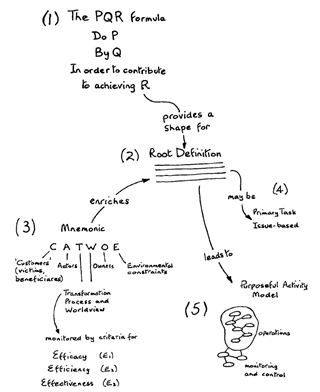LC 00479: verschil tussen versies
Geen bewerkingssamenvatting |
Geen bewerkingssamenvatting |
||
| Regel 1: | Regel 1: | ||
A Human Activity System (HAS) can be defined as a notional system (i.e., not existing in any tangible form) where human beings are undertaking some activities that achieve some purpose. They are used in SSM to establish worldviews of people involved in a problematic situation. The assumption is that people are inclined to act purposefully according to their worldviews. | |||
A worldview (Weltanschauung) captures the beliefs, desires and intentions of a person. In cite{Learning for action}, the example is given of the purpose of putting an offender in prison. It may be seen as a place for punishment, as a process of rehabilitation, or as a university for educating criminals. A person almost never adheres to a single worldview, instead elements of worldviews are typically combined. And this is the purpose of SSM: to accommodate worldviews to find acceptable ways for all involved to change. | |||
Principle: people differ in worldviews, but nevertheless they typically adhere to aspects of multiple worldviews, which provides room for accommodation. | |||
A HAS in SSM is made up of several elements, including the PQR formula and CATWOE eventually leading to a Purposeful Activity Model (PAM). For the sake of completeness, a distinction can be made between the scope of a SSM investigation: Primary Task (PT) or Issue-Based (IB). A PT kind of investigation focuses on the core business of an organization or a department. The system boundary coincides with these organizational units. A problematic situation that cuts across organizational boundaries are considered of IB type. For modeling activities, the distinction between PT and IB is not important. However, it does matter in a SSM investigation because stakeholders tend to think in terms of existing PT structures, which can hamper to take on a broader IB view. So, the notion of PT and IB type of investigation can be kept in mind to avoid the pitfall of being trapped in small mindsets. | |||
''Toestemming vragen voor het gebruik van deze figuren, anders moeten we ze zelf opnieuw tekenen.'' | |||
<accesscontrol>Access:We got to move</accesscontrol> | |||
[[Bestand:Process leading to a Purposeful Activity Model.png|gecentreerd|miniatuur|392x392px|'''Figure:''' Process and elements leading to a Purposeful Activity Model.]] | |||
{{LC Book config}} | {{LC Book config}} | ||
{{Light Context | {{Light Context | ||
| Regel 12: | Regel 23: | ||
|Show title=Ja | |Show title=Ja | ||
|EMM access control=Access:We got to move, | |EMM access control=Access:We got to move, | ||
}} | }} | ||
{{LC Book additional | {{LC Book additional | ||
|Preparatory reading= | |Preparatory reading= | ||
|Continue reading= | |Continue reading= | ||
}} | }} | ||
Versie van 28 mei 2020 12:59
A Human Activity System (HAS) can be defined as a notional system (i.e., not existing in any tangible form) where human beings are undertaking some activities that achieve some purpose. They are used in SSM to establish worldviews of people involved in a problematic situation. The assumption is that people are inclined to act purposefully according to their worldviews.
A worldview (Weltanschauung) captures the beliefs, desires and intentions of a person. In cite{Learning for action}, the example is given of the purpose of putting an offender in prison. It may be seen as a place for punishment, as a process of rehabilitation, or as a university for educating criminals. A person almost never adheres to a single worldview, instead elements of worldviews are typically combined. And this is the purpose of SSM: to accommodate worldviews to find acceptable ways for all involved to change.
Principle: people differ in worldviews, but nevertheless they typically adhere to aspects of multiple worldviews, which provides room for accommodation.
A HAS in SSM is made up of several elements, including the PQR formula and CATWOE eventually leading to a Purposeful Activity Model (PAM). For the sake of completeness, a distinction can be made between the scope of a SSM investigation: Primary Task (PT) or Issue-Based (IB). A PT kind of investigation focuses on the core business of an organization or a department. The system boundary coincides with these organizational units. A problematic situation that cuts across organizational boundaries are considered of IB type. For modeling activities, the distinction between PT and IB is not important. However, it does matter in a SSM investigation because stakeholders tend to think in terms of existing PT structures, which can hamper to take on a broader IB view. So, the notion of PT and IB type of investigation can be kept in mind to avoid the pitfall of being trapped in small mindsets.
Toestemming vragen voor het gebruik van deze figuren, anders moeten we ze zelf opnieuw tekenen.
Dit is een beveiligde pagina.

